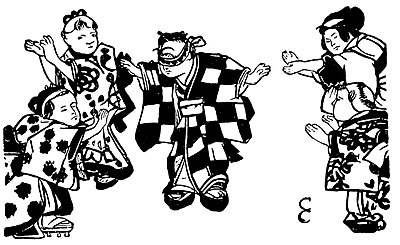Child-life in Japan and Japanese Child Stories/Games
GAMES.
HE games we are daily playing at in our nurseries, or some of them, have been also played at for centuries by Japanese boys and girls. Such are blindman's buff (eye-hiding), puss-in-the-corner, catching, racing, scrambling, a variety of "here we go round the mulberry bush." The game of knuckle-bones is played with five little stuffed bags instead of sheep bones, which the children cannot get, as sheep are not used by the Japanese. Also performances such as honey-pots, heads in chancery, turning round back to back, or hand to hand, are popular among that
long-sleeved, shaven-pated small fry. Still better than snow-balling, the lads like to make a snowman, with a round charcoal ball for each eye, and a streak of charcoal for his mouth. This they call Buddha's squat follower "Daruma," whose legs rotted off through his stillness over his lengthy prayers.
 Eye-Hiding, or Blindman's Buff.
Eye-Hiding, or Blindman's Buff.
As might be expected, some of the Japanese games differ slightly from ours, or else are altogether peculiar to that country. The facility with which a Japanese child slips its shoes on and off, and the absence on the part of the parents of conventional or health scruples regarding bare feet, lead to a sort of game of ball in which the shoes take the part of the ball, and to hiding pranks with the sandal, something like our hunt the slipper and hide-and-seek. On the other hand, kago play is entirely Japanese. In this game, two children carry a bamboo pole on their shoulders, on to which clings a third child, in imitation of a usual mode of travelling in Japan. In this the passenger is seated in a light bamboo palanquin
 Stilts and Clog-Throwing
borne on men's shoulders. A miniature festival is thought great fun, when a few bits of rough wood mounted on wheels are decorated with cut paper and evergreens, and drawn slowly along amidst the shouts of the exultant contrivers, in mimicry of the real festival cars. Games of soldiers are of two types. When copied from the historical fights, one boy, with his kerchief bound round his temples, makes a supposed marvellous and heroic defence. He slashes with his bamboo sword, as a harlequin waves his baton, to deal magical destruction all around on the attacking party. When the late insurrection commenced in Satsuma, the Tokio boys, hearing of the campaign on modern tactics, would form attack and defence parties. A little company armed with bamboo breech-loaders would march to the assault of the roguish battalion lurking round the corner.
Stilts and Clog-Throwing
borne on men's shoulders. A miniature festival is thought great fun, when a few bits of rough wood mounted on wheels are decorated with cut paper and evergreens, and drawn slowly along amidst the shouts of the exultant contrivers, in mimicry of the real festival cars. Games of soldiers are of two types. When copied from the historical fights, one boy, with his kerchief bound round his temples, makes a supposed marvellous and heroic defence. He slashes with his bamboo sword, as a harlequin waves his baton, to deal magical destruction all around on the attacking party. When the late insurrection commenced in Satsuma, the Tokio boys, hearing of the campaign on modern tactics, would form attack and defence parties. A little company armed with bamboo breech-loaders would march to the assault of the roguish battalion lurking round the corner.
Wrestling, again, is popular with children, not so much on account of the actual throwing, as
from the love of imitating the curious growling and animal-like springing, with which the professional wrestlers encounter one another. Swimming, fishing, and general puddling about are congenial occupation for hot summer days; whilst some with a toy bamboo pump, like a Japanese feeble fire-engine, manage to send a squirt of water at a friend, as the firemen souse their comrades standing on the burning housetops. Itinerant street sellers have, on stalls of a height suited to their little customers, an array of what looks like pickles. This is made of bright seaweed pods that the children buy to make a "clup!" sort of noise with between their lips, so that they go about apparently hiccoughing all day long. The smooth glossy leaves of the camellia, as common as hedge roses are in England, make very fair little trumpets when blown after having been expertly rolled up, or in spring their fallen blossoms are strung into gay chains.
On a border-land between games and sweets are the stalls of the itinerant batter-sellers. At these the tiny purchaser enjoys the evidently much appreciated privilege of himself arranging his little measure of batter in fantastic forms, and drying them upon a hot metal plate. A turtle is a favorite design, as the first blotch of batter makes its body, and six judiciously arranged smaller dabs soon suggest its head, tail, and feet.


